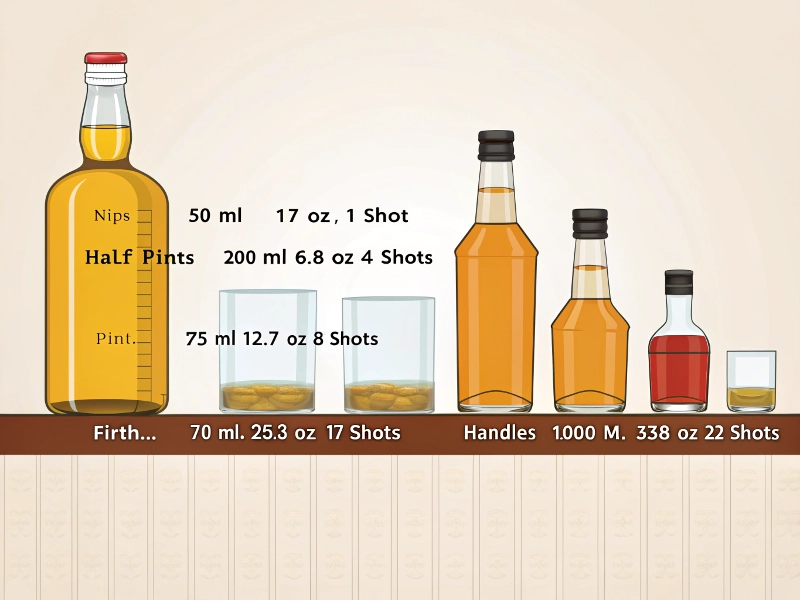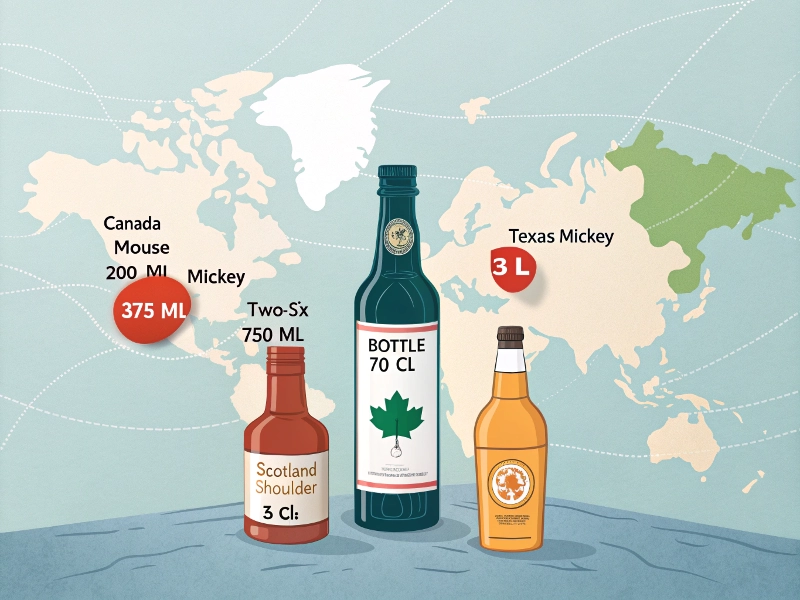Introduction
Liquor store shelves dazzle with bottles, but their sizes puzzle even savvy buyers. From tiny nips to grand bottles, each size carries a story of tradition and commerce. Yet, confusing labels, global variations, and hidden market shifts make choosing the right size a challenge. How can you master liquor bottle sizes to make confident choices? This comprehensive guide equips you with the knowledge to navigate measurements, practical uses, global standards, and cultural trends, ensuring clarity, value, and appreciation in every decision.
This guide unravels bottle sizes for consumers, bartenders, and distillers. It draws on industry insights, regulations, and real-world experiences to help you buy wisely, stock bars, or design brands.
This guide delivers a clear path through liquor bottle sizes, covering:
- Standard and less common sizes clarify measurements and uses, offering precise details for confident decisions.
- Practical applications guide size selection, aligning choices with diverse needs.
- Global standards and regulations shape size availability, requiring awareness of differences.
- Cultural trends and market shifts add depth, highlighting nuances and challenges.
Faced with a complex array of bottles, understanding their measurements and uses sets the foundation for confident choices.
Standard and Less Common Liquor Bottle Sizes
Liquor bottles range from tiny nips to grand bottles, designed for diverse needs. But misleading terms like “pint” for 375 ml confuse buyers. What are the key liquor bottle sizes, and how do they translate into practical measurements? Standard and less common sizes provide a clear foundation, offering precise milliliters, ounces, and shot counts for confident purchasing and pouring.
- Common sizes range from 50 ml to 1.75 L, covering nips (50 ml, 1.7 oz, 1 shot), half pints (200 ml, 6.8 oz, 4 shots), pints (375 ml, 12.7 oz, 8 shots), fifths (750 ml, 25.4 oz, 17 shots), liters (1,000 ml, 33.8 oz, 22 shots), and handles (1,750 ml, 59.2 oz, 39 shots). A 750 ml fifth serves a small gathering, while a nip slips into a pocket for travel. A shopper saved $10 by choosing a 1.75 L handle over minis for a party.
- Less common sizes serve premium markets, with magnums (1.5 L, 50.7 oz, 34 shots), jeroboams (3 L, 101.4 oz, 67 shots), and rehoboams (4.5 L, 152.2 oz, 101 shots, a large bottle for events). High costs limit their use, but they shine at weddings. A magnum adds flair to a celebration.
-
Shot counts ensure accurate pouring, with 1.5 oz as the US standard (Utah: 1 oz) for inventory planning. A 750 ml fifth yields 17 shots, preventing waste.
Size Milliliters Ounces Shots (1.5 oz) Nip 50 ml 1.7 oz 1 shot Half Pint 200 ml 6.8 oz 4 shots Pint 375 ml 12.7 oz 8 shots Fifth 750 ml 25.4 oz 17 shots Liter 1,000 ml 33.8 oz 22 shots Handle 1,750 ml 59.2 oz 39 shots
“Accurate shot counts like 17 shots for a 750 ml fifth streamline bar operations.”
— Michael Lee, Hospitality Management Expert
With a clear grasp of bottle sizes, selecting the right one for specific needs requires practical strategies to maximize value.
Practical Applications for Choosing Bottle Sizes
Liquor bottle sizes cater to varied scenarios, from sampling spirits to stocking bars. Choosing incorrectly risks overconsumption, inventory waste, or profit loss. How do you select the right bottle size? Practical applications guide size selection, optimizing choices for consumers, bartenders, and distillers.
- Consumer scenarios drive size choices, with minis (50 ml) for travel or sampling, fifths (750 ml) for two-person meals or home bars, and handles (1.75 L) for parties. New buyers can confidently ask for 750 ml bottles, the most common size for home use. A traveler tucks a 50 ml nip into a bag.
- Bartenders optimize inventory with shot counts, as a 750 ml fifth yields 17 shots or 6 pours. Shrinkflation—shrinking sizes (e.g., 750 ml to 710 ml) while keeping prices and appearances the same—cuts pours to 5, reducing 20% profit margins (revenue lost per bottle, per 2024 Beverage Retail Association study). A bartender noticed fewer cocktails from a 710 ml bottle.
- Distillers align sizes with branding, analyzing consumer preferences, competition, costs (e.g., handles save 10% per liter), shelf space, and regulations. Steps include:
- Analyze target audience (e.g., premium vs. budget).
- Evaluate shelf space and costs.
- Use custom engravings to stand out.
- Store navigation avoids term confusion, using specific milliliters (e.g., “750 ml”) or pointing to bypass mislabels like “pint” for 375 ml. A shopper corrected a clerk offering a 375 ml bottle as a “pint.”
“Point to a 375 ml bottle or say its size to avoid confusion.”
— Sarah Nguyen, Retail Consultant
Size Checklist:
- Choose 50 ml minis for travel or sampling.
- Select 750 ml fifths for meals or bars.
- Use 1.75 L handles for parties.
- Specify milliliters (e.g., “750 ml”) in stores.
With practical choices clarified, global standards and regulations shape what’s available, requiring awareness of their influences.
Global Standards and Regulatory Influences
Liquor bottle sizes vary worldwide, reflecting local traditions and rules. Differing standards and complex regulations confuse buyers and businesses. How do global standards and regulations shape liquor bottle sizes? Global standards and regulatory influences shape size availability, requiring awareness of regional differences and compliance.
Historical Roots of Sizes
- Historical roots define standards, with the 750 ml fifth from the 1866 French law for Bordeaux exports, aligning with the UK’s reputed quart (757.7 ml). A 225 L barrel fills 300 x 750 ml bottles. The EU’s 700 ml, divisible by 25 or 35 ml shots, suits bars.
Regional and Regulatory Standards
- Regional standards add diversity, with Japan’s 720 ml for sake and spirits, and Canada’s 750 ml despite its metric system.
- TTB regulations ensure transparency, mandating visible contents and 8% headspace (empty space in a bottle) for standard containers (e.g., 750 ml max 815 ml) and allowing unique designs for non-standard ones (e.g., 750 ml max 882 ml).
- 2025 TTB updates increase flexibility, adding 700 ml and 945 ml sizes and removing can vs. bottle distinctions, aligning the US with global markets.
“2025 TTB rules add 700 ml bottles, aligning US with global standards.”
— Dr. Robert Hayes, Regulatory Policy Analyst
Having explored global standards, cultural trends and market shifts reveal how sizes shape perceptions.
Cultural Trends and Market Shifts
Liquor bottle sizes carry cultural weight, from local slang to innovative designs. Market shifts and social behaviors challenge perceptions. How do cultural trends and market shifts impact liquor bottle size choices? Cultural trends and market shifts add depth, highlighting nuances and challenges.
Shrinkflation Challenges
- Shrinkflation frustrates consumers. How does shrinkflation trick you into paying more for less? It shrinks sizes (e.g., 750 ml to 710 ml yields 5 pours instead of 6) while keeping prices and appearances the same, cutting 20% bar profit margins (2024 Beverage Retail Association study). Shoppers feel cheated by identical-looking bottles holding less.
“Shrinkflation deceives with same-looking bottles holding less liquor.”
— Laura Bennett, Consumer Advocacy Specialist
Cultural Naming Nuances
- Regional naming enriches culture, with Canada’s “Mouse” (200 ml), “Mickey” (375 ml), “Two-Six” (750 ml), “Sixty” (1.75 L), “Texas Mickey” (3 L), Scotland’s “bottle” (70cl), and Ireland’s “shoulder” (35cl). A Canadian grinned ordering a “Two-Six”, embracing its charm.
Market Innovations
- Market innovations reduce waste and boost branding, with larger bottles cutting packaging waste by 10% per liter and custom designs (e.g., etched logos on 750 ml bottles boosting sales 20%, per 2025 distillery survey) using 3D-printed molds in 2025 to cut design costs by 15%. A sleek vodka bottle caught eyes on a shelf.
- Alcoholism shapes size preferences, with minis limiting intake to one shot nightly or hiding drinking, and handles risking excess. A recovering drinker chose minis to control temptation.
“Custom designs in 2025 enhance branding with innovative molds.”
— David Kim, Distillery Operations Director
Conclusion
This comprehensive guide to liquor bottle sizes equips you with the knowledge to navigate measurements, practical uses, global standards, and cultural trends, ensuring informed decisions. From standard sizes like 750 ml yielding 17 shots to practical choices like minis for travel, global influences like US vs. EU standards, and cultural nuances like “Mickey” and shrinkflation, you can choose confidently while staying vigilant. Master bottle sizes, use specific milliliters, and embrace cultural trends while watching for market shifts.






